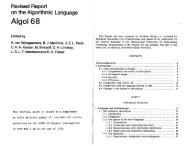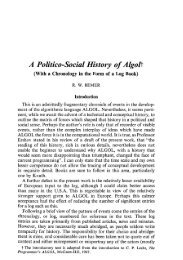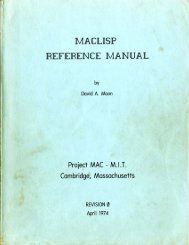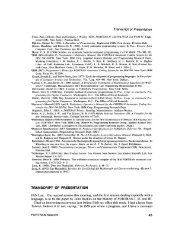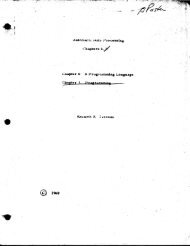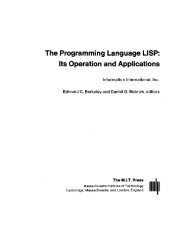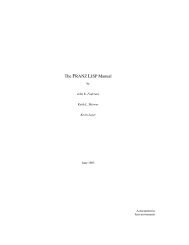LISP I Programmer's Manual - Software Preservation Group
LISP I Programmer's Manual - Software Preservation Group
LISP I Programmer's Manual - Software Preservation Group
You also want an ePaper? Increase the reach of your titles
YUMPU automatically turns print PDFs into web optimized ePapers that Google loves.
Let f be an expression that stands for a function of twointeger variables. It should make sense to write f(3,4) andthe value of this expression should be determined. The ex-2 2pression y +x does not meet this requirement; y +x(3,4) is nota conventional notation, and if we attempted to define it wewould be uncertain whether its value would turn out to be 132or 19. Church calls an expression like y +x a form. A formcan be converted into a function if we can determine the correspondencebetween the variables occurring in the form andthe ordered list of arguments of the desired function. Thisis accomplished by Church's h-notation.is a form in variables xl, ..., xn, then h ( (xi, . . . ,xn) ,E)Ifwill be taken to be the function of - n variables whose value isdetermined by substituting the arguments for the variablesxl, . . . ,xn in that order in d and evaluating the resulting ex-2pression. For example, A((x,y),y +x) is a function of two2variables, and h((x,y),y +x) (3,4) = 19.The variables occurring in the list of variables of aA-expression are dummy or bound, like variables of integrationin a definite integral. That is, we may change the names ofthe bound variables in a function expression without changingthe value of the expression, provided that we make the samechange for each occurrence of the variable and do not make twovariables the same that previously were different. Thus h ( (x,y),2 2 2y +x),A((u,v),v +u) and h((y,x),x +y) denote the same function.We shall frequently use expressions in which some of thevariables are bound by A's and others are not. Such an expressionmay be regarded as defining a function with parameters.The unbound variables are called free variables.An adequate notation that distinguishes functions from formsallows an unambiguous treatment of functions of functions. Itwould involve too much of a digression to give examples here,




